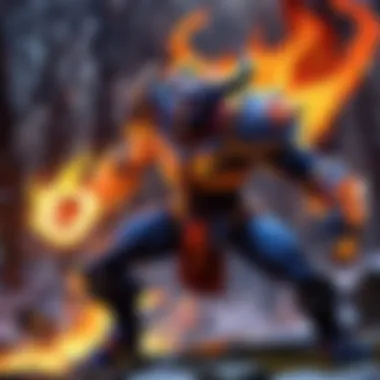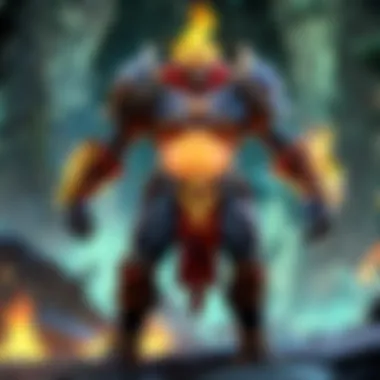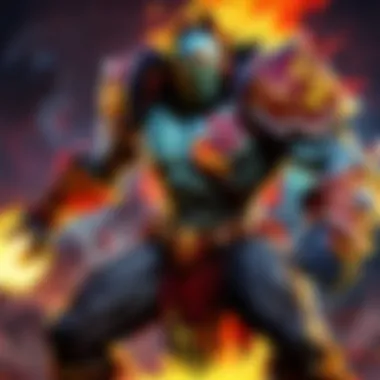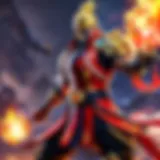The Flickering Flame: Strategies and Dynamics in Dota Games


Intro
The flickering flame serves as a powerful analogy for the dynamics found within the world of Dota games. This concept reflects the ephemerality that characterizes strategies, hero choices, and player engagement. The Dota community is inhabited by dedicated gamers who analyze and adapt continuously to changes. For them, understanding this fluctuation is not merely interesting; it is essential for improving their gameplay and expanding their knowledge.
Players from all levels experience a range of challenges brought on by the ever-shifting landscape. Frequent updates and patches mean strategies become transient; what works today might not yield success tomorrow. Moreover, fluctuations in player performance and commitment impact community interactions and individual development. Thus, delving into these dynamics yields insights that are vital for both competitive athletes and casual players in the Dota ecosystem.
This article unfolds various aspects of these dynamics, exploring everything from hero guides to marketplace trends. Participants in the Dota community can expect to gain a nuanced understanding of their environment, arming them with the knowledge to navigate the complexities of this popular game. Each section is thoughtfully designed to shed light on an element of the immersive Dota experience.
Preamble to Flickering Flame in Dota
The concept of the flickering flame within Dota represents a constantly shifting landscape of strategies and player engagement. Understanding this dynamic is vital for anyone involved in the game, from casual players to professional esports athletes. This section provides foundational insights into what defines the flickering flame and how it influences both gameplay and community interactions.
Defining the Concept
At its most basic level, the flickering flame refers to the erratic nature of gameplay elements in Dota, which include hero selection, game mechanics, and overall player commitment. Within any match, strategies can diverge and converge based on team dynamics and opposition tactics. This volatility illustrates the intricate interactions between player decisions and the current state of the game. As a player, recognizing the illumination and obscurity in decision-making is crucial. One minute an unconventional hero composition may dominate, and the next, it may be rendered ineffective by suddenly popular counter-threats. Essentially, the flickering flame symbolizes instability yet offers room for adaptability and creative approaches.
Historical Context in Gaming
To better grasp the flickering flame concept, it is important to consider its predecessors in the domain of video gaming. Historical fluctuations in game meta have infiltrated many titles before Dota, shaping subsequent evolutions. Games such as StarCraft expanded players’ understanding of strategy, promoting a landscape where old patterns could quickly become obsolete with each patch release.
The transition from the original Dota to Dota 2 marked a stark shift in availability and community involvement. The Dynamics closely observed today have roots in shaping gameplay metrics within early versions of Dota. Over time, adaptive strategies grew in significance, showcasing the player’s need to address continuously shifting game environments. This understanding allows players to embrace the fleeting nature of hero viability, encouraging both strategic depth and an appreciation for relative performance fluctuating.
The flickering flame encourages adaptation in gameplay, highlighting the importance of agility in strategy formulation.
Overall, this foundational understanding delivers appreciation for the inherent complexities accompanying Dota games. Furthermore, examining how competitive datasets, trends, and popular heroes have evolved throughout the years solidifies the impact that fluctuations possess in creating and sustaining robust gaming experiences.
Game Mechanics and Strategies
Game mechanics serve as the backbone of any game, and in the realm of Dota games, strategies are molded largely by them. Understanding game mechanics and their implications allows players to adapt and thrive in a dynamic environment. This section dives into how nuances in mechanics shape hero selection and adaptability, presenting a multifaceted view of participation in Dota.
Hero Selection and its Variability
Hero selection is an essential variable in Dota gameplay. The sheer number of heroes, each with unique abilities and attributes, lets players exercise choice based on personal playing style, team composition, and the ongoing game conditions. The variability in hero selection ensures the gameplay remains diverse and engaging.
When selecting a hero, players must consider their position on the map, their role in the team, and the strategies they plan to implement. A capable support hero will offer a different set of advantages compared to an aggressive core hero. This difference impacts not only individual performance but also the synergy between team members.
Additionally, environmental factors, such as the current patch and meta trends, bolster the variability in hero selection. Players actively must monitor ongoing tournaments and community discussions on platforms like reddit.com to assess which heroes might be more effective in the current meta.
This confronts players with a continuous challenge. Emerging builds or hero pairings might shift expectations abruptly, resembling the flickering of a flame—often intense, but sometimes diminished. Thus, flexibility becomes vital.
Adaptation to Meta Changes
Meta changes in Dota often stem from patches released by Valve. These updates tweak game mechanics, re-balance hero abilities, and introduce new elements that can significantly impact gameplay. Understanding and quickly adapting to these shifts is crucial for sustaining success.


Changes in hero positioning or ability effectiveness can shift a dominant strategy overnight. Thus, players need to be observant and willing to revise their strategies and hero selections. A fading strategy today may become the strength tomorrow, similar to how a flickering flame can rekindle unexpectedly.
Players can adopt an analytical approach by analyzing changes from previous major patches available in articles on en.wikipedia.org or britannica.com. Accessing detailed breakdowns can elucidate which heroes or approaches trended well during the last tournaments and led to notable wins.
To remain competitive, players must be proactive in adjusting their gameplay. This allows them to outmaneuver strategies utilized by others who have yet to assess the new meta dynamics effectively. Players are encouraged to participate in community forums, engage in scrimmages, or even study professional games to learn how to effectively transition their tactics in the profoundly transforming landscape.
Ultimately, the ability to understand and adapt to shifting mechanics serves as a testament to one's dedication within the Dota community. It portrays a commitment to continuous learning and strategic advancement, integral to nurturing one's flickering flame of passion in gaming.
Player Engagement and Commitment
Understanding player engagement and commitment is essential for a complete grasp of the dynamics present in Dota games. This topic delves into how players connect with the game, affecting both their personal experience and overall performance in the community. The relation between engagement and commitment can dictate the longevity and enjoyment of the game for many.
High player engagement often leads to greater retention rates within the game. Players who are truly invested tend to explore various facets of Dota. This includes honing their skills, understanding hero complexities intricately, and mastering confi synergies. They not only participate but also contribute to strategic discussions encompassing game mechanics and character build variations. Players who delve deeper uncover the subtleties that can redefine their gameplay experience.
Equally, commitment shapes player interaction with the community. Players who feel a sense of loyalty are more likely to support their team and engage in group activities. It transforms the Dota experience into a shared journey. This collective commitment fosters camaraderie while crucially enhancing the game atmosphere.
Fluctuating Skill Levels
Fluctuating skill levels indicate the complexity and inadvertently the nature of competition in Dota 2. The transient skills of players signify that engagement is barely static and caters to a broad spectrum of abilities. New players may initially perceive the game mechanics as overwhelmingly intricate, which can result in an inconsistent commitment level. Over time, learning curves through gameplay can enhance their capabilities significantly.
Advantages of Fluctuating Skill Levels:
- Skill Development: Players are motivated to improve as they encounter diverse gameplay experiences.argument from varied opponents.
- Team Dynamics: These shifts lead to unique team compositions wherein skilled players guide less experienced teammates, replicating in-game strategy despite disparities in individual skill.
However, constant transformation in skills calls for attention from both players and the community. As some surge to higher tiers, others may find themselves lingering at various ranks, causing possible frustrations within matchmaking sequences.
Motivational Factors in Participation
Motivational factors play a significant role in players' decisions to remain part of the game. Incentives extend well beyond the surface, impacting how committed players are when engaging with Dota. Some may play purely for the challenge, while others seek social connections or financial rewards connected to esports.
Consider the motivations shared by the community:
- Competition frequently serves as a powerful driver for many players. Matching wits against diverse challengers keeps the interest high and promotes a desire to rise in the ranks.
- Community Support is essential. Players often thrive when partaking in synergetic interactions with peers through in-game chats, social media https://www.facebook.com pages, and platforms like Reddit https://www.reddit.com for strategy or meta discussions.
- Recognition and Rewards incentivize effort and commitment. Players often chase after achievements, rankings, and even in-game monetary rewards, hoping to carve out a recognizable niche within the game's broader artistic arena.
Awareness of these factors can enhance developers' understanding, promoting ongoing efforts to create an environment where engagement thrives through various improvements or community engagement initiatives.
Community and Social Dynamics
Community and social dynamics are essential aspects of the Dota universe. The interaction among players significantly enhances the overall experience. Strong connections within the community foster growth, encourage collaborative play, and improve individual and team performance. Players find shared experiences and goals through multiplayer dynamics.
These dynamics dictate the flow of information and strategies, impacting how players approach the game. Successful foliage of players leading to learning opportunities where they share insights about gameplay, contributing to skill and understanding improvements collectively. In the context of a constantly changing meta, social connections allow gamers to adapt efficiently. Players often discuss now ideas and techniques to thrive in evolving game conditions instead of depending solely on official channels or guides.
Additionally, social dynamics inspire a sense of belonging. Players engage with different communities based on interest levels, dedication, or expertise; this segmentation drives healthy competition. Positive reinforcement from peers increases motivation and enhances enjoyment. Activating teamwork not only benefits each gamer's individual journey but can lead to stronger overall community performance.


The community evolves due to continuous interaction, ultimately creating resilient networks that enable players to sustain long-term commitment.
Building Connections through Gameplay
The gameplay experience itself forms the foundation of meaningful connections. When players share the Dota journey, they naturally forge friendships. The dynamics of competition and collaboration amplify chances of forming bonds. Many gamers report that personal connections formed through gameplay are lasting and enrich their Dota experience significantly.
Strategies could include:
- Participate in Team Matches: Playing in organized groups rather habvit than solo queue helps strengthen communication and strategy.
- In-Game Communication: Sharing helpful tactics during gameplay increases not just player connection but collective problem-solving.
- Custom Games: Engaging in personalized formats allows players to explore different styles together while fostering teamwork.
Interacting beyond just gaming sessions, such as attending tournaments, can also increase connections.
Further, these connections build trust. Players learn to rely on each other, significantly impacting each bout’s outcome. Many experienced players offer mentoring or support to incoming newcomers during this journey, strengthening community ties.
The Role of Online Communities
Online platforms have grown in importance for Dota players. Their existence transcends mere gameplay, enabling structured dialogue on diverse topics, from hero strategies to career advice and everything in-between. Forums, streaming platforms like Twitch, and Reddit threads serve as hubs for shared knowledge.
- Connectivity: Players can discuss problems and share achievements from all around the globe. Such immediacy empowers everyone involved.
- Resource Sharing: Websites and platforms curate guides and social interactions. Players share everything from innovative playstyles or heroes choices that might counter a certain type of game or opponent.
- Technical Support: Common issues with gameplay, installation tactics, and updates find quick relevance in these circles as players assist one another.
These communities become breeding grounds for initiatives in broader contexts, including charity events, development opportunities, and esports tournaments that nurture the evolving Dota culture. The sense of belonging together prompts the growth of participation both locally and globally. Community members have means to influence both gameplay and social environment, ultimately molding high-quality resources alongside regular information exchanges.
By honing community participation, both engagement levels and game knowledge increase, lending critical effects in individual gameplay, art of strategies, and longer-term player retention. Ultimately, the community and social dynamics act as vital supports, enriching each Dota experience.
Impact of Esports on Player Dynamics
The interplay between esports and player dynamics is critical for understanding the landscape of games like Dota 2. With the rise of professional gaming, distinctions entrenched in casual play and competitive esports blur. On one hand, the growth of esports serves as a catalyst underlying many dynamics facing players. On the other hand, it deeply influences personal engagement and community behavior. This section will discuss two pivotal elements: competitive integrity and performance, and sustainability of player participation.
Competitive Integrity and Performance
Competitive integrity is the backbone of esports. Ensuring fair competition is necessary to maintain players' trust and commitment. With a professional setup, players must adhere to strict regulations to sustain values such as respect and honesty. Discrepancies in performance dynamics can arise from unethical behaviors like match-fixing or unsportsmanlike behavior. Therefore, creating a secure environment against such risks is paramount.
From a performance perspective, esports competitions elevate player expectations. Aspiring players can analyze strategies observed from professionals, apply them in their own gameplay, and experiment through practice. This iterative cycle enhances their skills as they decode the complex game mechanics specific to Dota 2. Improved player performance fosters higher engagement levels, resulting in a more robust player-base capable of sustaining enthusiasm for the game.
"For players, Dota 2 transcends beyond just a game; it becomes a laborious journey toward mastery, surrounded by an evolving community tightly bonded by competition."
Sustainability of Player Participation
Sustainability in player participation is equally vital as new benchmarks in esports create pressures on players. Over time, the influx of fresh talent raises concerns about burnout. Players juggle personal well-being alongside competitive titles, cultivating a fragile balance. Truly, with career longevity in question, consideration for psychological and physical health becomes paramount.
Meanwhile, established professionals frequently contribute to the longevity of junior players through mentorship. Thus, returning the cycle of knowledge enhances inclusivity in Dota 2 as seasoned diplomats age gracefully in the ecosystem. The imploration of diverse competition can revolutionize how players see performance, shifting from purely winning to sharing knowledge, thus nurturing sustainable practices within gaming circles.
Balancing ambition with well-being remains essential. Without proper support, the gaming experience risks rotating power structures, ultimately marginalizing potential future leaders in the esports culture. Strategies must evolve to retain player dynamism while fostering inclusion in competitive engagement.


To sum up, the dichotomy of competitive integrity versus the sustainable structure forms layers of intricate influence shaping Dota players. It pushes them toward growth while posing questions regarding the evolution of practices and structures across gaming communities.
The Evolution of Hero Dynamics
The concept of hero dynamics in Dota is essential for understanding how gameplay evolves over time. These dynamics encompass the decision-making processes behind hero selection, the intricate relationships among various characters, and their interactions within an evolving game landscape. Players must navigate these elements deftly, using strategic acumen to optimize team compositions and compute risks. The flickering flame metaphor aptly illustrates how players’ engagement with heroes fluctuates, reflecting adaptability and situational awareness.
Assessing Hero Effectiveness Over Time
Hero effectiveness is an ever-changing variable shaped by both community gameplay styles and individual player skill. Various factors influence the ratings of heroes in Dota: past performances in competitive play, synergy with other heroes, and individual contribution in-game, among others.
- Meta Shifts: A major aspect is understanding that metas shift due to balance adjustments by developers. Patch notes that may buff certain heroes or nerf overperforming ones can change strategic hirings.
- Player Adaptation: Players need to assess hero viability through not just performance metrics but contextual adaptability across situations. Success rates could drastically vary between player skill levels and ranked tiers, which amplifies the need for proactive evaluation.
To track changes, resources such as Dotabuff can be used, enabling players to monitor hero statistics over time. This holds critical importance for players aiming to harness the dymamics properly, using insights gathered to forecast changes in hero bandwagon tendencies.
The Role of Updates and Patches
Regular updates and patches play a prominent role in shaping hero dynamics within Dota communities. These are essential in maintaining a balanced gaming environment. Updates influence many game elements including:
- Hero Balancing: Developers may release buff and nerf adjustments to heroes altering their viability in tournament play and ranked matches.
- Item Changes: Aspirations to maintain balance can lead to overbearing items getting reworked or deprecated through patch updates. Consequently, new item synergies arise, which may influence hero choices dynamically.
Communication regarding these patches is critical. Change logs are published alongside documentations by gaming companies affecting various aspects of gameplay. For beginners or players who are less informed, consistent tracking of these elements can produce knowledge gaps, weakening one's performance. Websites like Dota2.com serve as an article potent resource to check updated patches. In essence, these updates not only facilitate game freshness but also reshape community engagement, sparking discussions.
Important to note is: > "The flickering flame thrives on adaptation; without it, predictability sets in, stifling progress."
Overall, the evolution of hero dynamics constitutes both a challenge and an opportunity for insightful players keen to engage with Dota's strategic aspects, aligning their choices with the nuances of an ever-evolving gameplay environment.
Culmination: Embracing the Flickering Flame
In the exploration of Dota and its evolving landscape, the "flickering flame" serves as a metaphor for the unpredictability and flux inherent in both gameplay and community dynamics. Recognizing this concept assists players and enthusiasts in understanding how connections, strategies, and engagement fluctuate over time. This realization is crucial in embracing the intertwined nature of individual gameplay experiences and broader community trends.
At the heart of the discussion is the understanding that adaptability is vital. The game does not remain stagnant, and neither should the players' approaches. As players transition through various phases of skill, motivation, and community interaction, they should hold the flickering flame close, becoming attuned to the rhythm of changes within the game.
Additionally, the dynamics of strategy in Dota reflect a continuous dialogue between players. This build-on yields benefits in terms of enhanced team coordination. Understanding this inspires deeper reflections on the importance of teamwork and collaboration.
"In Dota, every flicker of the flame represents an opportunity to learn and connect with others."
Finally, the implications are not limited to gameplay alone. This cycle of flickering intimacies can substantially influence the sustainability of the player base. Awareness of fluctuations in player engagement can lead not only to improved individual satisfaction but also to the vitality of the community as a whole.
Final Thoughts on the Dota Experience
The Dota experience encompasses more than mere gameplay. The connections forged through this game highlighting the intricate web of camaraderie that emerges in high-pressure situations must be appreciated. Every match becomes a microcosm of social interactions that reveal the character of the players involved, their battles, sacrifices, and triumphs.
Through sharing multiple games, players gain insight into not just strategy but also emotional resilience. It is this emotional bonding, combined with strategic instincts, that allows individuals to build satisfying experiences. Each victory or loss nurtures player identity and equalizes standing amongst opponents, transcending mere competitiveness.
Future Perspectives in Gaming
Looking ahead, the significance of the flickering flame in gaming cannot be overstated shifting paradigms are expected as new mechanics and community-driven content affect flow of gameplay and player relationships. We are likely to see greater emphasis on holistic sustainability in player lifecycles.
Moreover, as technology advances including AI-driven matchmaking and evolving in-game strategies emerge, players will need to adapt more swiftly. The interplay of technology with player dynamics will provoke shifts in how teams unite, develop strategies, and practice collaborazione.
Lastly, game developers will play a critical role in shaping player interaction. Emerging trends aim for deeper pathways for social connectivity both in and out of game. The future prescribes a rich tapestry where the flickering flame indicates adaptability, forging connections and enhancing long-term participation within the community.



